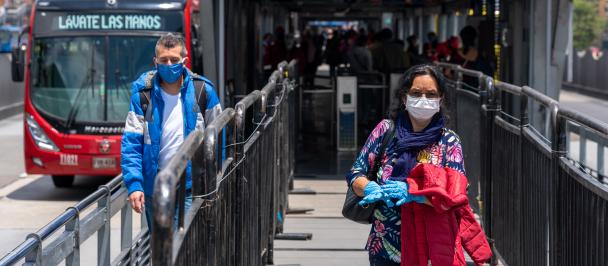The research captured 37 million results from 4.4 million profiles across all public platforms including Twitter, Facebook, YouTube, Instagram, media domains, blogs and other digital communities. Photo: UNDP Uruguay
An unprecedented information pollution challenge – what the World Health Organization (WHO) refers to as an “infodemic” – has accompanied the health, social and economic crisis caused by COVID-19. This is not only hindering the effectiveness of public health responses but also undermining social cohesion and political stability around the world.
To better understand the scale and nature of this challenge in Latin America and the Caribbean, UNDP commissioned a social and digital media research study that analyzed the public digital sphere in Spanish and English from October 2020 to February 2021.
The research, carried out by Constella Intelligence, captured 37 million results from 4.4 million profiles across all public platforms including Twitter, Facebook, YouTube, Instagram, media domains, blogs and other digital communities.. Here is what we found:
1. Let’s put things in perspective
COVID-19 sparked an enormous volume of conversations in the public digital sphere. Most of this content – approximately 60 percent – consisted of news and neutral exchanges – an important reminder of the critical role played by the digital public sphere in ensuring broad access to essential information at a time of great uncertainty. Jokes and satire – a key coping mechanism in times of heightened stress – also emerged as a major component of online conversations, generating nearly 1 in 4 of all reviewed comments. The bulk of the conversation about COVID-19 – online just as offline – revolves around pertinent questions and legitimate opinions. Engaging with these is at least as important as responding to information pollution.
2. Much of the debate about COVID-19 is really a debate about politics
Discussion of policies adopted in response to the pandemic generated nearly 1 in 5 of all comments. Many of these expressed criticism of government actions and worries about delays in the arrival of vaccines. In many cases, these discussions reflected and deepened political polarization that pre-existed COVID-19. Often, they had roots in the exceptionally high levels of distrust towards public institutions that have been building in the region over the last decade. Here, once again, can be seen how the COVID-19 crisis in the region has also been a crisis of governance.
3. Still there is a lot of pollution out there
Approximately 1.4 percent of the reviewed content could be classified as clear-cut information pollution (false, manipulated and misleading information produced and transmitted with or without a harmful intent). While the proportion may seem small, it corresponds to half a million items over four months, which has an outsized impact on vulnerable audiences. Some of the most common information pollution narratives – accounting for approximately 40 percent of the “polluted” content reviewed” – are linked to possible side effects of vaccines and the perceived benefits of alternative COVID-19 treatments. Other narratives revolve around the supposed harm caused by mask use and a rejection of social distancing as an effective form of prevention. This content has had a significant impact in undermining the response by encouraging disregard of proven public health measures and jeopardizing efforts to control the pandemic.
4. Feelings of loss of control fuel conspiracy theories
In Latin America and the Caribbean, many have escaped extreme poverty over the last two decades. However, many continue to lack the opportunities and the resources to shape their lives. Despite progress to middle-income status in many countries, significant economic vulnerability remains a reality for large segments of the population across the region. Feelings of lack of control and the related anxieties have interacted in powerful ways with COVID-19, fueling conspiracy theories that describe the pandemic as part of a plot concocted by hidden and distant powers. Content of this nature accounts for 45.6 percent of the information pollution detected by the study. Hashtags like #plandemia and #covid1984 are among the most popular in these conversations.
5. Think “traditional” media is becoming irrelevant? Think again.
The production of COVID-19 related content in the digital sphere is concentrated, with the top 200 influencers generating 1 in 4 results. More than half of these profiles belong to media (76 percent of which are international) outlets. As a comparison, 11 percent belongs to political figures. Global media sites are the most shared across the region with CNN, El País, Russia Today, New York Times, BBC and Reuters having the most impact. It is clear, that media outlets continue to play a major role in shaping public discourse and that constructive engagement with these outlets remains indispensable for all actors seeking to promote the circulation of evidence-based information.
6. Yet, junk media play a key role in spreading pollution
While a significant amount of information pollution is created by repackaging, reframing, and reproducing out of context content produced by mainstream media, the research identified several websites that were established with the primary purpose of generating disinformation. Several of these domains were registered in 2020 in response to the pandemic but have ties with established conspiracy and alternative media. Understanding the incentives driving the creation of these websites and how they are embedded in networks of disinformation will be a key step towards addressing information pollution dynamics.
7. Conversations are mostly local
The mapping reveals that the biggest communities on Twitter and Facebook are generated by country specific conversations. The highest levels of interaction occur between communities in the same country and no single community occupies a central position for sharing information. Most influencers have impact in only one country, while 30 percent have regional influence. Effective engagement with these conversations will require therefore highly localized strategies.
8. But pollution is decidedly global
If we zoom in on “polluted” content, we observe very different patterns of propagation with a heavy influence of global conversations: in fact, one in 5 of the influencers in this space are geolocated in the United States, one in 10 in Spain. A cross-country Spanish-speaking community sits firmly at the centre of the information pollution network maintaining strong interactions with country-based communities. The Caribbean, on the other hand, appears to be especially vulnerable to information pollution “imported” from users in the United States. A coordinated, cross-border approach may be needed to address this dynamic.
Countries in Latin American and Caribbean region are feeling the effects of second or third waves of the pandemic, governments are also tackling unprecedented vaccination efforts. It is thus important that countries create the conditions for the timely dissemination of accurate and understandable information, based on science and evidence, to all communities.
Counteracting information pollution will require context-specific and multi-pronged strategies. The development of effective social listening and information pollution detection systems will be a key first step. Greater transparency of public action, active media engagement, the strengthening of information verification capacities and community participation are some of the other measures that will be required. None of this is easy but there is no question that urgent action is needed to clear the air and to combat COVID-19 related mis- and disinformation, instill vaccine confidence and save lives.

 Locations
Locations





